Nexera Prep SFC System - Features
Semi-Preparative Supercritical Fluid Chromatography System
-
Unique LotusStream separator technology achieves higher recovery rates
-
Solid autosamplers for increasing loading capacity
-
Prep Solutions enables a seamless preparative workflow
-
Compact, benchtop design
-
Choose the optimal configuration for your application
-
Fully automated on-line extraction and fractionation
-
Nexera Prep SFC reduces environmental impact
Unique LotusStream separator technology achieves higher recovery rates
Unique technology achieves higher recovery rates
SFC shortens analysis times
Due to the low viscosity and high diffusivity of supercritical CO2, column back pressure for supercritical fluid chromatography supercritical fluid chromatography (SFC) is low even at high flow rates which enables faster analysis without sacrificing column efficiency. This allows significantly shorter analysis times than HPLC. In purification using SFC, the target compounds are recovered in high concentrations in an organic solvent, which saves time not only during analysis, but also during post-run processing after preparative tasks are complete. The Nexera Prep SFC maximizes fractionation output with its high recovery rates and ability to carry out continuous preparative work that further shortens the user's waiting time.
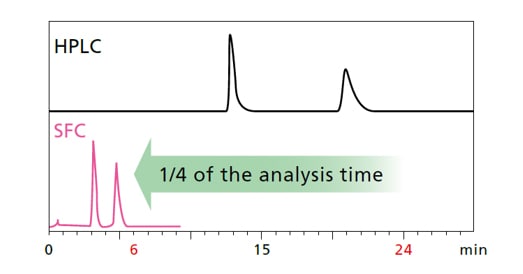
High recovery rates
In preparative SFC, one factor that results in lower recovery rates is increased dispersion of the eluant when the CO2 returns suddenly from a supercritical to a gaseous state. The patented LotusStream gas-liquid separator successfully reduces sample dispersion and carryover, while also achieving high recovery rates. High recoveries can be obtained regardless of flow rate or modifier concentration, even for volatile compounds such as the fragrance linalool.
| Equipment | Recovery rate |
| Conventional separator | 78.0% |
| LotusStream Separator | 96.7% |
LotusStream separator (patented technology)
The LotusStream gas-liquid separator reduces flow speeds by splitting flow through multiple flow channels. The CO2 is discharged externally while the liquid travels along the column and drips directly below in a focused stream.
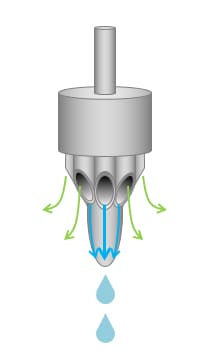
Direct fractionation into vials
Direct fractionation into 96-well plate
Stacked injection function eliminates waiting time
Normal injection wastes time between peak elutions. Using the Nexera Prep SFC’s stacked injection function, samples can be injected continuously without any waiting time, enabling more samples to be processed. Settings for this function can be specified easily in the dedicated software Prep Solution.
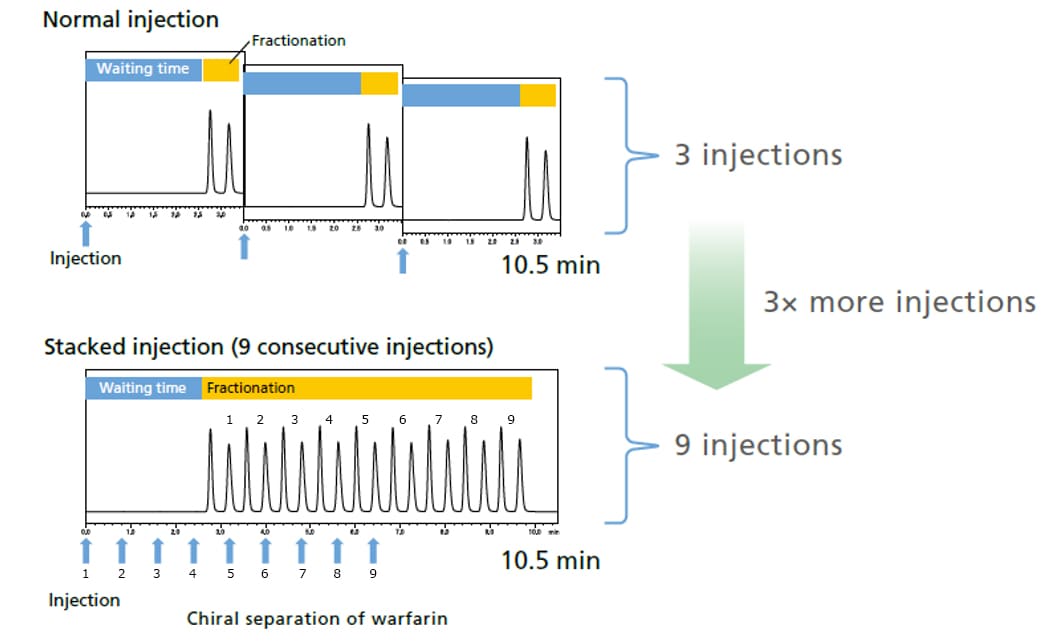
Simple post-run processing
Because most of the mobile phase is vaporized supercritical CO2, only the organic solvent (modifier) added to change the polarity of the mobile phase remains after preparative work. Since there is no water content in the recovery fraction, the concentration time is significantly shorter.
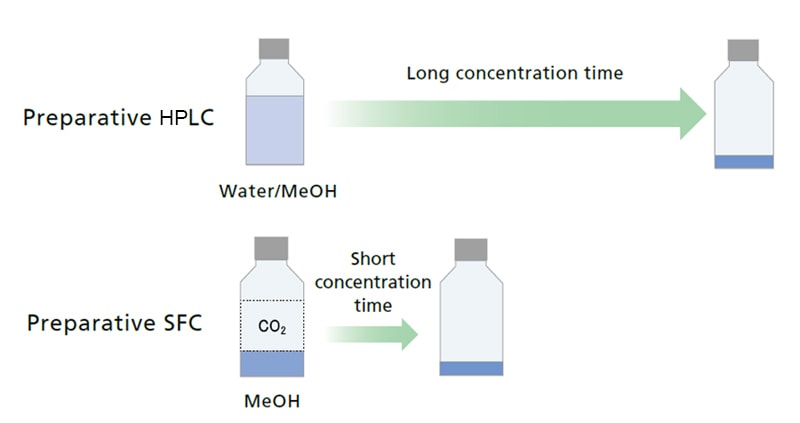
Solid autosamplers for increasing loading capacity
More of the target compound can be fractionated at once by loading a large volume. However, this can sometimes lead to poor separation and broad peak shapes because of sample solvent effects. By performing fractionation with the on-line SFE-SFC, solid samples can be enclosed in an extraction vessel and extracted directly without dissolving in a solvent. A good peak shape prevents simultaneous elution of contaminants and improves the purity of the target component.
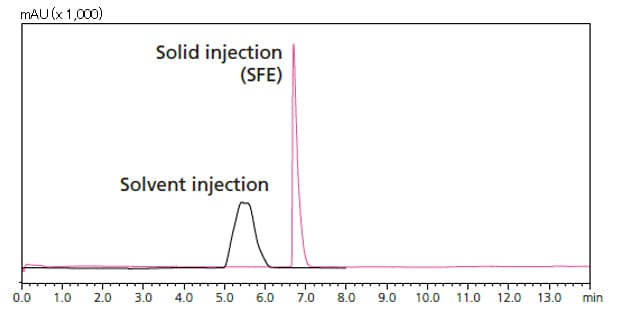
Prep Solutions enables a seamless preparative workflow
The dedicated software, Prep Solution, ensures that it is simple to scale up from an analytical to a preparative workflow, and makes it easy to configure parameter settings. It greatly increases the efficiency of preparative workflows.
Easy to understand even for first-time users
The parameter settings in Prep Solutions have been kept as simple and intuitive as possible, so that all users can operate the system without confusion. This also avoids the risk of wasting samples through human error.

A single analysis prior to fractionation confirms the peak elution positions. Analysis can be started by simply inputting basic parameters in the three onscreen tabs.

The chromatogram obtained from the single analysis can be displayed in the simulation window, so that fraction ranges can be selected by eye using the mouse. These settings can be applied to methods automatically.


Samples are fractionated based on the user-selected parameters. The fraction range is displayed on the chromatogram, which can be checked in real time.

Parameter settings for fractionation and injection can be adjusted during stacked injection ("on-the-fly" function).

Compact, benchtop design
This space-saving benchtop model includes a carbon dioxide pump that does not require an external chiller (cooling system for the heat source). In addition, one unit can handle multiple flow volumes, lowering installation costs.
Benchtop system that can be installed anywhere
Usually a chiller is required to cool the solvent delivery pump when pumping CO2 at high flow rates. However, the Nexera Prep SFC features a compressor-type cooling unit, reducing the size of the system and allowing it to be installed anywhere. Its footprint is equivalent to an analytical scale SFC system.

Wide range of flow rates available
In a single system, the Nexera Prep SFC can handle ow rates from 10 to 150 mL/min for fractionation of a range of sample sizes, from a few hundred mg up to a few grams. Shimadzu provides various preparative systems, such as Nexera UC/s, which can perform SFC analysis and UHPLC analysis using a single system. The system corresponding to the application can be selected.
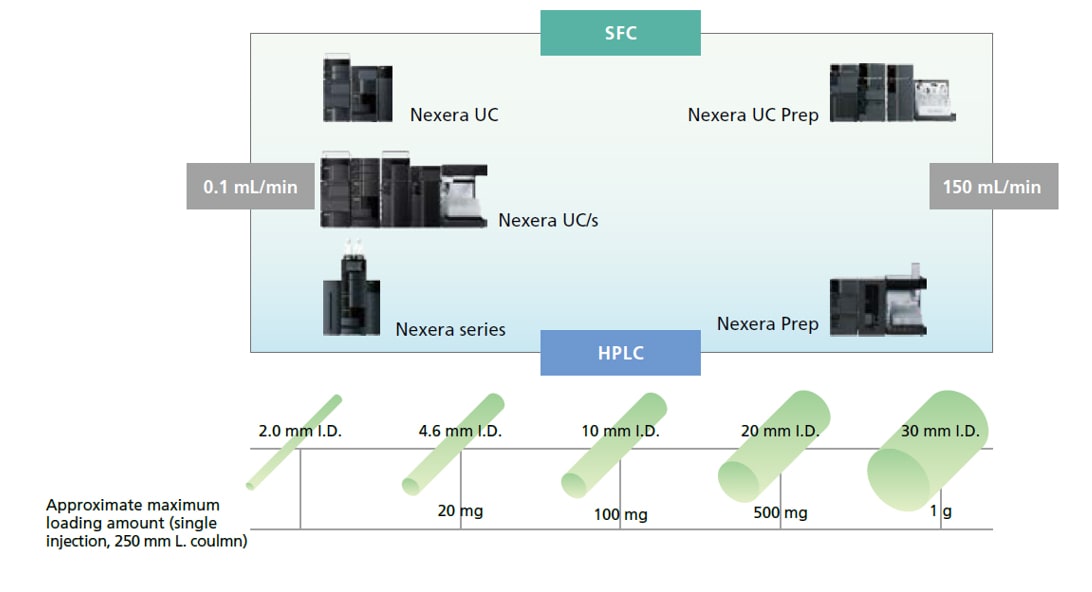
Add fractionation capabilities to the analytical SFC system
By adding a fraction collector to the analytical scale SFC system, it is possible to upgrade to a small-volume preparative system. A complete workflow can be carried out seamlessly on one system, from method development to fractionation.
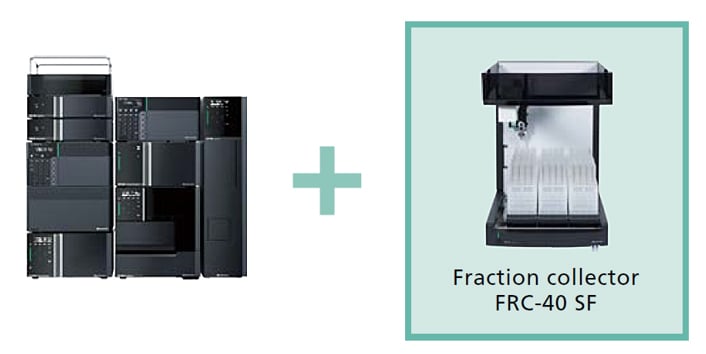
Shimadzu’s unique LotusStream separator allows fractionation of small volumes, even into vessels such as 1.5 mL vials, without scattering of the solvent.
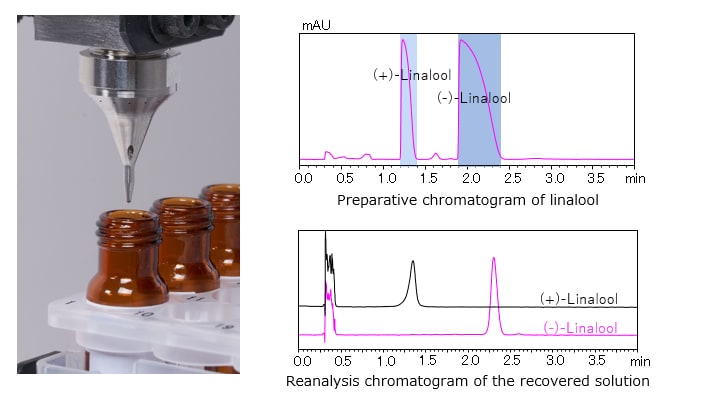
Choose the optimal configuration for your application
Stacked Fraction System: supports injection volumes up to 20 mL for high flow rates
This system is optimized for large volume fractionation involving repeated injection of samples which may contain several compounds. The FRS-40 unit includes both injector and fraction collector functionality, so that the same unit can be used for repeated sample injections and gram-level preparative work. It supports injection volumes up to 20 mL* and collection of ten fractions. Compatible with flow rates from 10 to 150 mL/min and 10 to 30 mm I.D. columns.
*optional

Multi-Fraction System: for multiple peak fractionation of impurities and natural products
This system is suitable for preparative tasks involving samples with many peaks detected, such as impurities in pharmaceutical compounds. Volumes of up to 2 mL* can be injected using an autosampler that holds up to 162 samples (using 1.5 mL vials). Three rack types can be selected for the FRC-40 SF fraction collector, which can recover up to 540 fractions (using 10 mL vials). With support for flow rates from 10 to 150 mL/min, columns with an internal diameter from 10 to 30 mm can be used.
*optional

Analytical Fraction System: analytical flow and fraction collection in one system
This system is intended for analytical scale fractionation only requiring fraction volumes of several mL to recover up to 20 mg of material (used to check synthesis for example). By connecting an FRC-40 SF fraction collector to the Nexera UC system, analytical columns from 2.1 to 4.6mm ID can be run at flow rates up to 5 mL/min for small volume fraction collection.
| Stacked Fraction System | Multi-Fraction System | Analytical Fraction System | |
|---|---|---|---|
| Flow rate range | 10.0 - 150.0 mL/min | 0.0001 – 5.0 mL/min | |
| Supported columns | I.D.: 10 - 30 mm Length: up to 250 mm |
I.D.: 2.0 - 4.6 mm
Length: up to 250 mm |
|
| Injection unit |
No. of samples processed: 1
Max. injection volume: 2 mL
(optional: 20 mL)
|
No. of samples processed:
252 (with 1 mL sample vial plate) 162 (1.5 mL sample vial plate) 84 (4 mL sample vial plate) 36 (10 mL sample vial plate) 72 (microtube plate) 288 (96-well microplate) 1,152 (384-well microplate) 288 (96-well deep-well plate)
1,152 (384-well deep-well plate)
Max. injection volume: 2 mL (using syringe option) |
No. of samples processed:
252 (with 1 mL sample vial plate) 162 (1.5 mL sample vial plate) 84 (4 mL sample vial plate) 36 (10 mL sample vial plate) 72 (microtube plate) 288 (96-well microplate) 1,152 (384-well microplate) 288 (96-well deep-well plate)
1,152 (384-well deep-well plate)
Max. injection volume: 5 μL (optional: 50 μL) |
| Collection |
Supported containers: Bottles (screw-top: GL45)
1000 mL x 10, 2000 mL x 5 Collection method: Valve switching (10 collection + 1 waste or 5 collection + 5 waste) |
Supported containers: Test tubes
30 mL sample vial x 54 250 mL sample bottle x 20
500/1,000 mL sample bottle x 12
Test tube O.D. 18mm x 216 Test tube O.D. 35mm x 54
Collection method: Open-bed with X-Y arm |
Supported containers: Test tubes
1.5 mL sample vial x 486
4 mL sample bottle x 252
Test tube O.D. 18mm x 540
Test tube O.D. 35mm x 216
96-well microplate/deep-well plate
Collection method: Open-bed with X-Y arm |
|
Volume recovered per analysis
(approx.) |
Up to 1 g
(for 30 mm I.D. column) |
Up to 20 mg
(for 4.6 mm I.D. column) |
|
| Sample temperature control range |
No temperature control
|
4 to 45°C | 4 to 40°C |
| Support functions | Dedicated preparative software, stacked injection, parameter changing during analysis |
Dedicated preparative software, parameter changing during analysis |
|
Fully automated on-line extraction and fractionation
Nexera on-line supercritical fluid extraction (SFE) , SFC is a revolutionary system that combines on-line SFE, SFC and, fraction collector in a single flow. Target compounds are extracted from solid samples and then automatically transferred to SFC/MS so that no human intervention is required. The Nexera Prep SFC on-line SFE–SFC system reduces sample preparation time and acquires highly accurate data. Preparation can be carried out by connecting a fraction collector.
On-line Automation of the extraction and analysis of functional components in natural products
Target compounds are extracted from solid samples and then automatically transferred to SFC so that no human intervention is required. In the case of tomato paste, after preparing for analysis in as little as 5 minutes, extraction, separation, and detection of lycopene are automatically carried out. In addition to a shorter sample preparation, Nexera Prep SFC can automate the extraction, analysis, and fractionation process with the addition of a fraction collector.
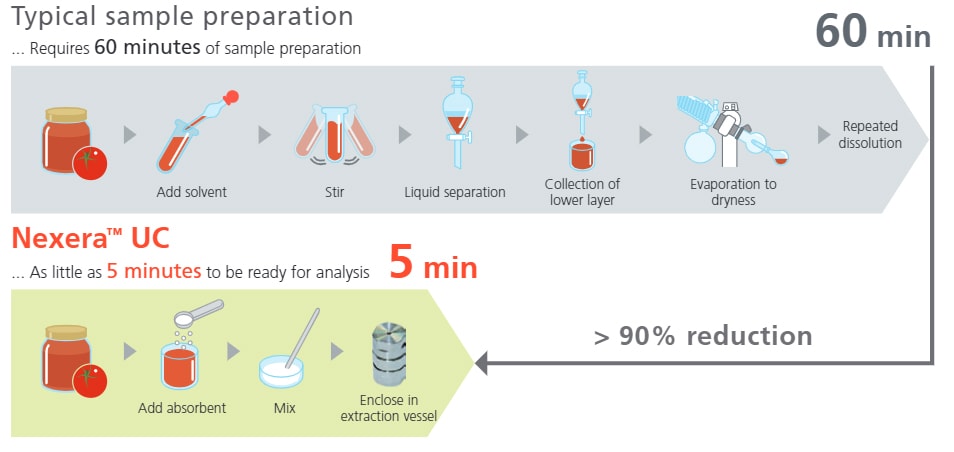
On-line SFE–SFC technology achieves a high recovery rate
After placing the extraction vessel in position on the SFE unit and starting analysis in LabSolutions™ (analysis software), extraction and purification are performed seamlessly. Online SFE–SFC enables the functional component “lycopene” to be automatically extracted from tomato paste. The amount of extracted lycopene is equivalent to the value indicated on the product packaging. On-line SFE–SFC technology achieves a high recovery rate.

Maximize fractionation output and labor-savings
On-line extraction, separation, and fractionation are possible by connecting a fraction collector at the end of the detector. Furthermore, scale-up from analytical to preparative scale increases the volume of fractions. The Nexera Prep SFE unit (maximum ow rate: 150 mL/min) with a preparative column enables high-volume extraction. On-line SFE-SFC can automatically run the extraction, purification and fractionation continuously day or night. The target compounds are recovered in high concentrations in an organic solvent, saving time during post-run processing after preparative tasks are complete.
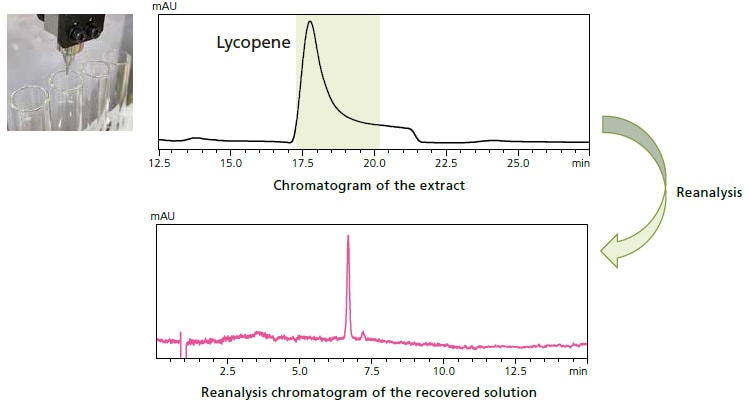
Nexera Prep SFC reduces environmental impact
Comparison of costs and consumption of organic solvent for a single analysis by conventional normal-phase LC vs. SFC is shown below. By using SFC, the total cost of analysis is reduced by 87.6% and the consumption of organic solvent is reduced by 94.2%.



